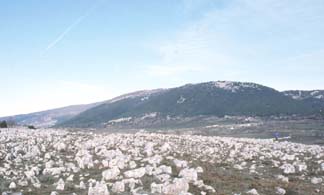 Spigno Mount (Gargano).
Spigno Mount (Gargano).GARGANO CAVES
Beyond to the Gargano well known for its tourist attractions and its religious rites, another aspect of this mountain exists. It's the karstic Gargano, with its extended knots of white limestone cliffs, its characteristic plateaus, its dolines and its fascinating underground world.
 Spigno Mount (Gargano).
Spigno Mount (Gargano).
The Gargano promontory is composed by a cliff structure limestone-dolomitiche which date back mainly to the Mesozoic Era. The karstism development has characterized the Gargano with a series of epigee and deep morphologies as short carsiche valleys covered from water course to torrential flow, karstic-tectonic widths hollows(called polje), extended dolines (superficial of plateau crivellate from hundred of depressions sluices), lives furrowed (areas contraddistinte from a multitude of furrows parallels between they), caves and abysses.
 Some dolines near Piana della Grava (S.
Giovanni R.)
Some dolines near Piana della Grava (S.
Giovanni R.)
The karstic territories hide in their subsoil a disowned and mysterious world, always however in clean antithesis with the external atmosphere. The karstic caves, in fact, are characterized from a mineral landscape, dipped in the more absolute dark, where the water that to the outside runs short, is recovered in abundance. In the Gargano they are known currently beyond 700 natural cavities comprised the coastal coves. The ipogee karstc manifestations are diffuse practically everywhwre, but the more interesting are located in the field western center of the Cape, where the deep kartsism are correlated to the presence of extended doline fields. Between the doline of the Gargano the Pozzatina Doline (to sthe outh of Saint Nicandro Garganico) is the more spectacular and imposing. This hallow, that has a perimeter of approximately 1,850 meters and a depth of beyond 100, is the deepest apulian doline and one of the greater ones of Italy.
 Pozzatina Doline (S. Nicandro G.co)
Pozzatina Doline (S. Nicandro G.co)
The overwhelming majority of the garganiche caves has a vertical course mostly and it is developed in agreement with the main tectonic lines that interest the Cape. The more important between all is the Grava of Campolato (near S.Giovanni Rotondo), the deeper natural cavity up till now explored in Puglia. It's constituted from an initial sink deep 100 meters from which a high and long meanderform gallery alternating with widths is detached smaller rooms, smalls lake and other jumps. This cave forwards in underground for beyond a kilometer catching up the depth of -303 metres from the campaign plan.
 Campolato Cave (S. Giovanni R.)
Campolato Cave (S. Giovanni R.)
In the territory of S.Nicandro Garganico opens the entrance of one of the more evocative and spectacular cavities of the entire Gargano: the cave of Pian della Macina. A gallery reaches high out a wide cavern in which it comes down through a deep sink-slide 15 meters. The room adorns of wonderful stalacto-stalagmitic concretions, columns and cloths. At the end of this cavern, a narrow passage between the concretions, concurs to reach in the last part of the cove: an authentic coffer of incomparable beauty, either for its concretions purity, or for its tipology (mainly eccentric stalactite and inflorescence composed of large calcite crystals).
 Pian della Macina Cave (S. Nicandro G.)
Pian della Macina Cave (S. Nicandro G.)
Near San Marco in Lamis is situsted the cave of Zazzano, majestic cavity characterized from a huge entrance sinking in the dark and from always it has provoking interrogative and curiosity in the people. This great well is deep 95 metres and lets in a subhorizontal gallery that continues for beyond 60 metres.
 Zazzano Cave (S. Marco in Lamis)
Zazzano Cave (S. Marco in Lamis)
The Pillars cave, near Rignano Garganico, is the wreck of a very more extended underground system which the near Paglicci cave belonged also, the most important situated famous preistorico known essentially for its palaeolithic parietal paintings. The cave of Montenero, near San Marco in Lamis is one of most famous and known natural cavities in the Gargano.
 Montenero Cave (S. Marco in Lamis).
Montenero Cave (S. Marco in Lamis).
A wide description of this cove goes back to first of the 1800. In fact, in" Physics Appula " (1806), Father M. Michelangelo Manicone from Vico del Gargano gave an account of this cave. Some others garganiche caves are: the Chinese abyss (-120 meters), the hole of Snake (-160 meters), the Cave of Coppa Grande (-120 meters), the abyss of Vixens (-120 meters), and some important archaeological caves as an the Scaloria Cave (Manfredonia). The directory is very long and every year becomes rich of new discovered. In this context Spelaeological Dauno Group ONLUS of Foggia since approximately thirty years works, always animated from a great passion and with some primary objectives as the study and the search, the protection of karstic atmosphere, the denunciation of situations to risk and, above all, the dissemination of the spelaeology. With its banns, its extensions, its conventions and course, Spelaeological Dauno Group has complyd and complys with its vocation primary to introduce, in the territory of National Park of the Gargano and beyond, the underground extraordinary beauties and the peculiarities so tied with the remaining ecosystem.